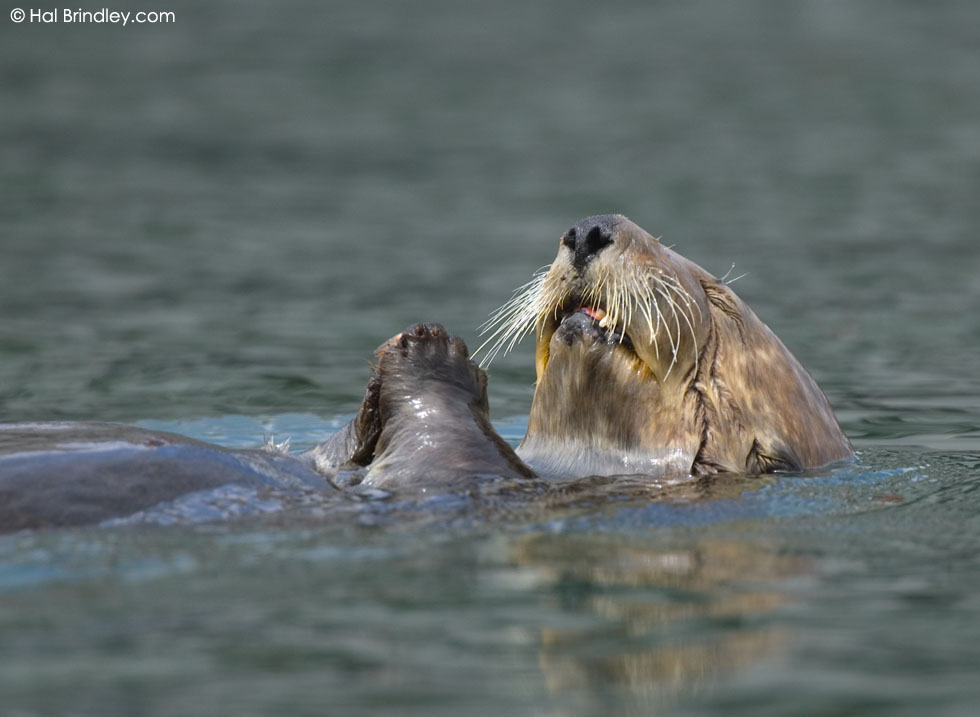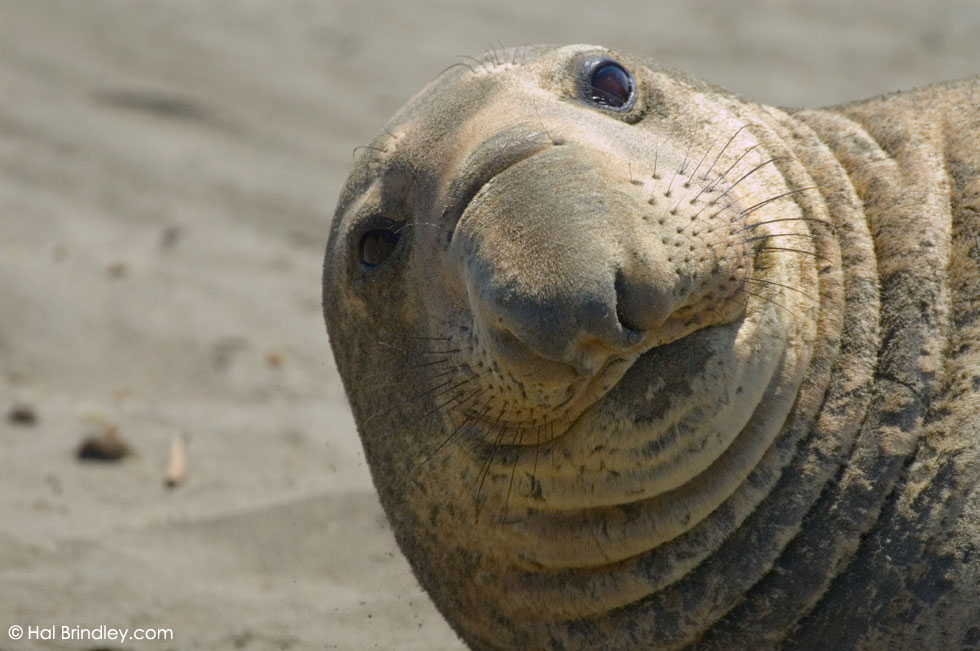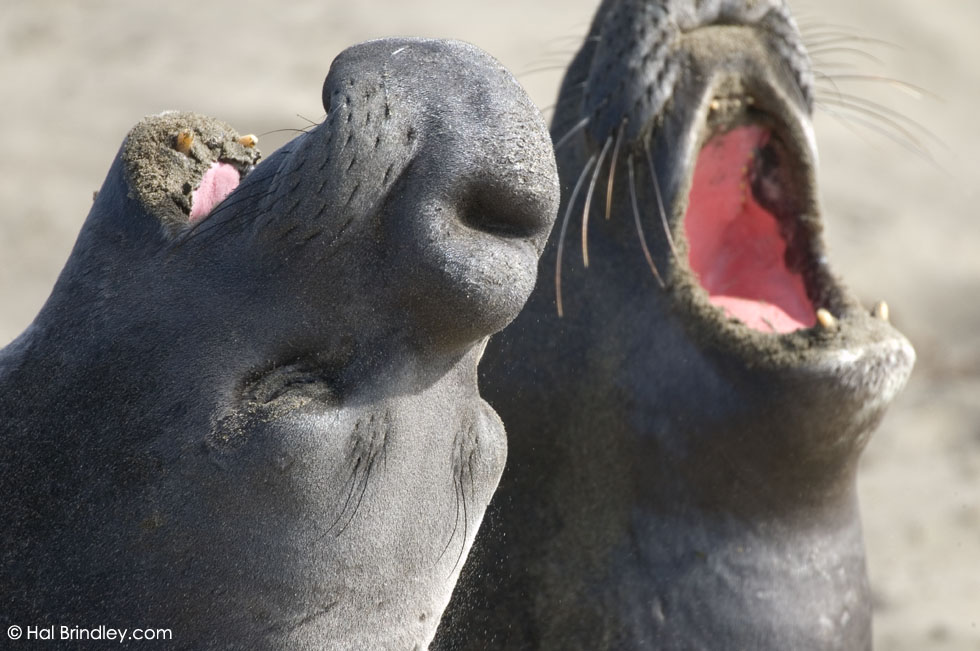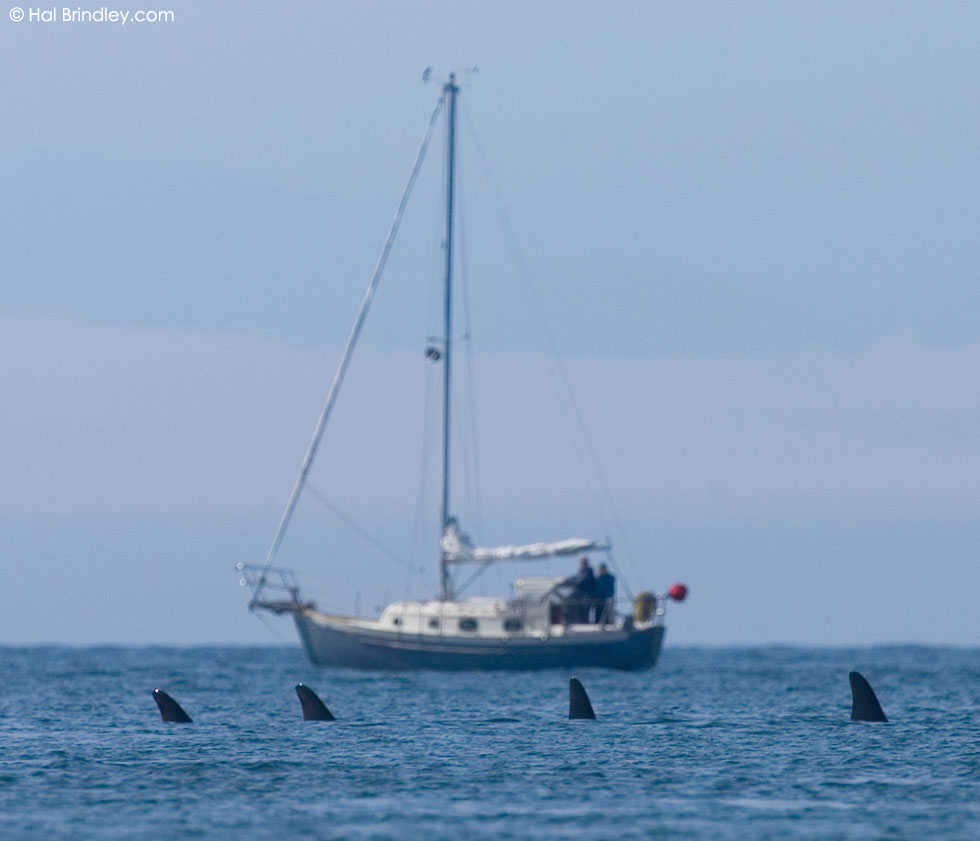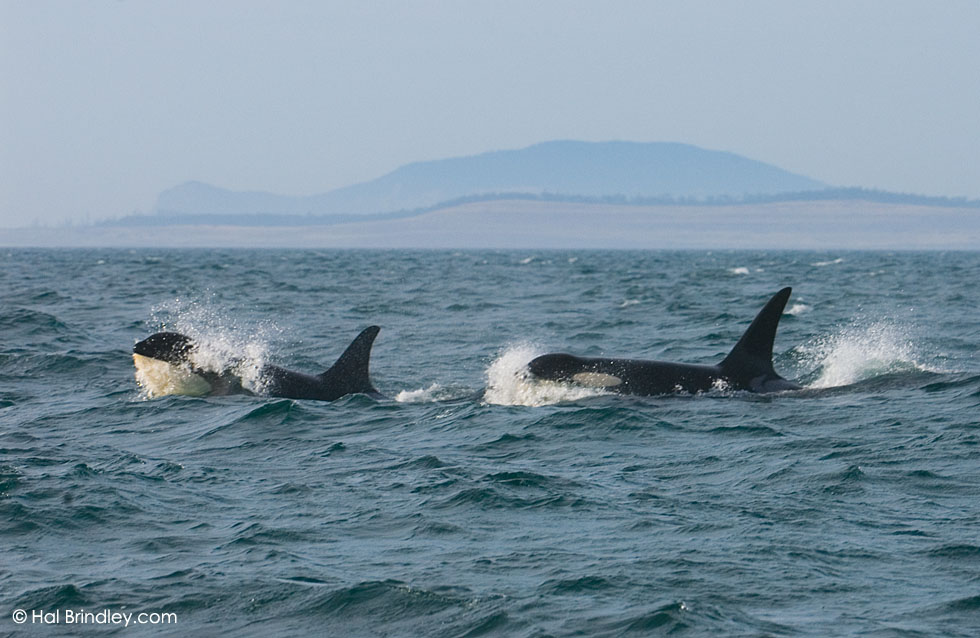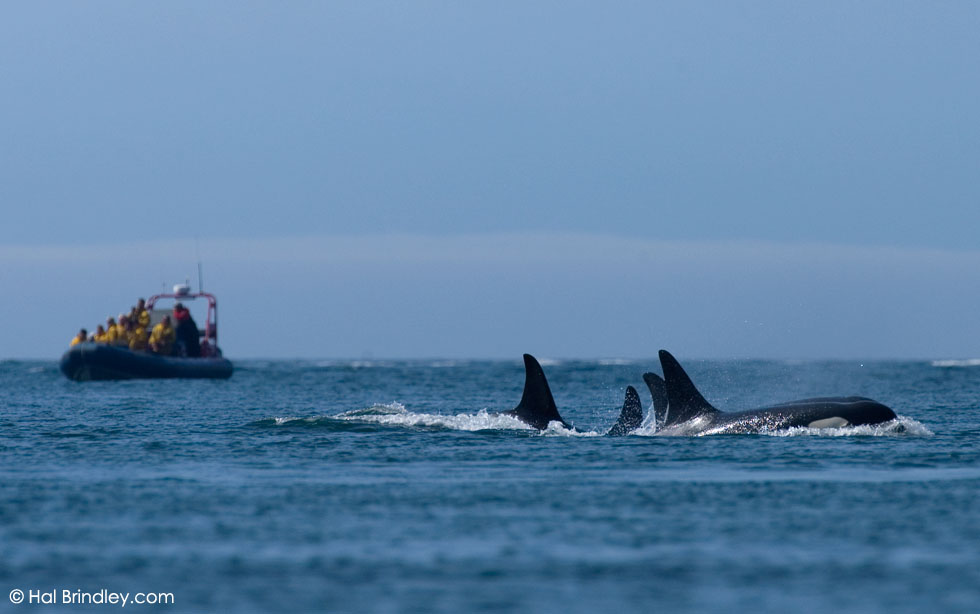
STAY HOME AND WORK!
This is what my conscience had been screaming at me for months. I’ve been trying to open a gallery in Charlottesville and the work is progressing slowly. I can’t afford the time or the money to take an exotic photo trip. This attitude caused me to develop a serious case of ants in the pants.
When I received an invitation to a wedding in California, I quietly cracked my conscience over the head with a sack of doorknobs and duct taped him to a chair with a sock in his mouth.
One maniacal laugh later, I’m on an airplane headed to Los Angeles. moo hoo hoo haw haw ha …
With only a few days to spare I decided to do a wham-bam tour of the amazing marine mammals of the American West Coast. I was psyched! Pumped up. With the base line to “Eye of the Tiger” pulsing in my head, I drove my rental car northward, determined to catch a glimpse.
All told I encountered 7 species of large mammal that I had never seen before in the wild. It was absolutely incredible. I’ll be counting them down here roughly in order of size, smallest to largest. The first (and possibly cutest) can be found in the underwater kelp forests shown here.

Uh, no, you’re right. This is not a picture of a mammal. It’s a fish. Good catch, man. I can’t get anything past you. It’s not even a real kelp forest. In fact, it was shot in the Monterey Aquarium. The next image however …

BAM! Right off the bat, I find the one animal that I was really dying to see, rolling around in the harbor at Morro Bay. Ladies and gentlemen,
Marine Mammal 1: the Sea Otter.
Good golly these guys are cute. They have an uncontrollable energy that causes them to constantly roll and tumble and frolic. It’s just irresistible. To maintain this ridiculous energy level, a sea otter must eat 20-25% of its body weight each day! How do they do it? Those nubby little fingers are capable of a surprisingly dexterous and unusual feat. Something that no other mammal, outside of primates, is capable of…
They use tools! A sea otter will use a stone to dislodge shell fish such as abalone from the ocean floor. Then it carries another rock to the surface to crack open the shell.
For two hours I watched an otter in Morro Bay doing just that. She would place a large rock on her chest and smash a clam or mussel onto it repeatedly. Sometimes she would use a big clam shell in place of the rock. Other times she would reverse the technique by holding a small rock between her paws and smashing the shellfish. I swear there must have been an all-you-can-eat seafood buffet down there because she came up with every sort of sea creature imaginable. In the top two photos she’s eating a clam and a crab.
The bottom left looks like some sort of sea cucumber. I have no idea what the bottom right one is. When she was done with her smashing-rock she would simply roll slightly to one side, let it slip off her belly and continue to eat. She also dumped her trash with this method as the shells were removed. Adorable I tell ya …
A Sea Otter’s Prayer: Thank you Mother Nature for allowing us to survive the humans for one more year. This is no joke. We humans very nearly eradicated this beautiful animal from the face of the earth. Once plentiful along the Pacific coast, by 1911 they were almost hunted to extinction for their fur. (The otter above is not actually praying, but cleaning its incredible fur coat that traps air and keeps it warm in chilly ocean waters.) Less than a thousand remained when the international hunting ban was signed.
The population is now estimated to be around 150,000 worldwide. That little oil spill caused by the Exxon Valdez killed 5,000 in one swoop. The southern population, found off the coast of California, consists of a mere 2,000 individuals (including this one) but appears to be in a state of decline. So it wouldn’t hurt for us to say a prayer for the amazing sea otter as well. (or contribute to their protection). and now,
Marine Mammal 2: the Harbor Seal.

Harbor Seals are the most widespread seal species on the planet, found in both Northern Atlantic and Pacific waters.
They belong to a group of mammals known as Pinnipeds which includes three families: the “true seals” (or Phocids), the “eared seals” (or Otariids), and the Walrus.
The Harbor Seal is a “true seal.” It can dive to a depth of 300 feet and stay submerged for up to 28 minutes! I shot these cute little buddies sunbathing in Monterey Bay.
It seems that harbor seals are always doing something cute, if you can get over the fact that they look like a giant slug with a puppy dog head. Although ridiculously awkward on land, harbor seals are graceful swimmers.
Like most true seals, they use their back flippers for propulsion and front flippers to steer. So have you figured out how a seal manages to spend almost half an hour under water? Guess what. I lied in the title of this story. They don’t actually hold their breath …
I’m willing to bet that when someone mentions the word “seal” this is the guy that pops into your head.
Marine Mammal 3: The California Sea Lion.

It is the superstar of aquarium and zoo and circus shows, the one that can balance a ball on its nose. The one that makes that classic barking seal sound. It, however, is not a “true seal.” It is an “eared seal.”
I bet you can guess at least one difference between true seals and eared seals. That’s right. Eared seals have ears. Well technically they both have ears. You just can’t see them on true seals. Eared seals have a funny little tootsie roll-sized ear that sticks out of their head.
Also eared seals can stand up on all four flippers (as in the photo above of one standing on a buoy) and even sort of gallop, whereas true seals just kind of undulate and drag themselves around on land.
In the water they propel themselves with their long front flippers, as if gracefully flying with wings. By some accounts, a California Sea Lion can dive as deep as 899 feet!
So back to the question at hand. If they don’t hold their breath, how do they do it?
The truth is, they EXPEL their breath before a deep dive. This might not seem to make any sense, but let me explain.
If a human (or any other mammal) dives to a deep depth, the intense pressure causes the air in our body cavities to compress and seep into our blood and tissue. As we come back up to the surface this gas re-expands. If we do it too quickly it can cause a very painful condition known as “the bends.” It’s like when you shake a can of soda and open it too quickly, That’s the explosive power of an expanding gas.
However, when a seal expels all the air from its lungs before a dive, it becomes virtually incompressible and technically can dive to any depth without experiencing decompression sickness on the way up. No gas to re-expand. But then there’s a new problem. Where does it get its oxygen? By the way, this photo was shot at a sea lion rookery in Monterey. (A rookery is a breeding colony.)
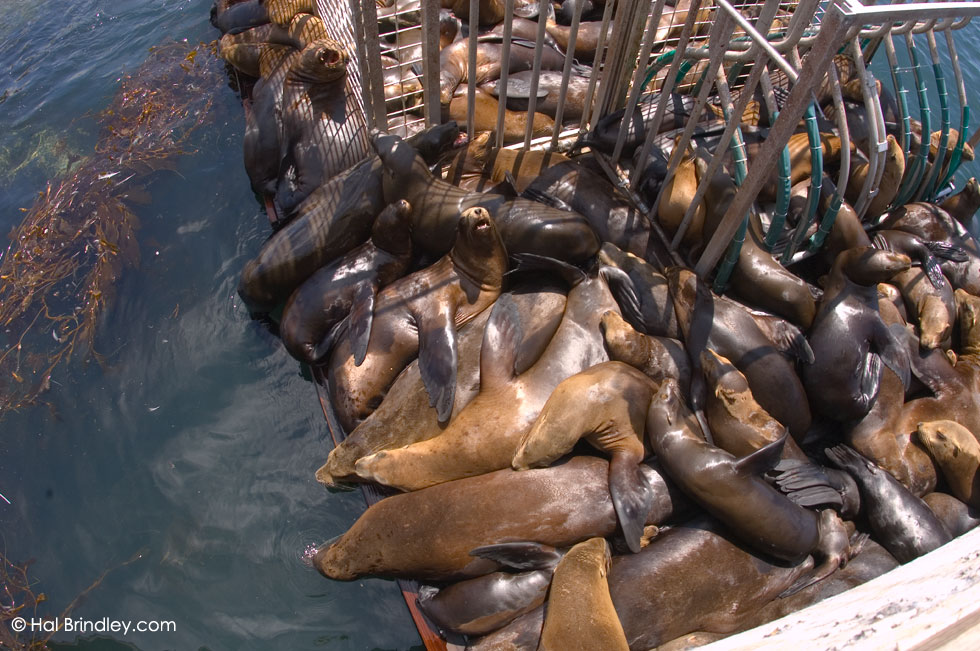
Seals have a whole slew of adaptations to address the oxygen problem. They include the ability to store quite a bit of oxygen in their blood and muscle tissue, a substantially slowed heart rate during a dive (sometimes as low as 7% of their normal rate), and the ability to slow and concentrate blood flow to the most critical body parts of the body (like the brain and heart) and away from the limbs. This is really amazing stuff.
So you see, a seal is not limited as to how deep it can go, only by the amount of time it can stay under based on how well its oxygen-storing ability has evolved. If you thought half an hour was a long time, wait ’til you hear about the champion diver of the seal family.
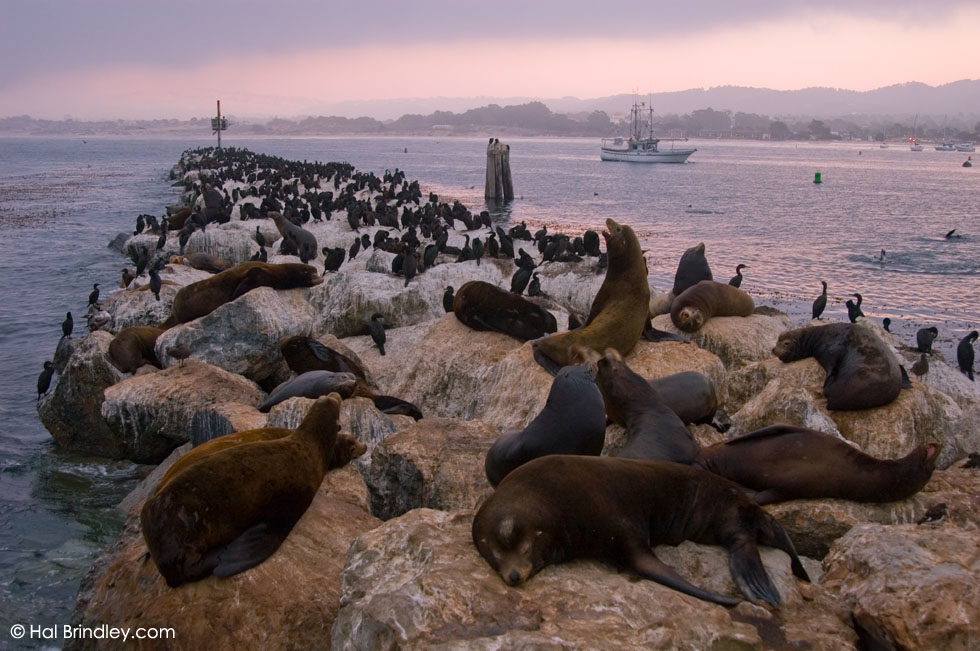
But first, a quick side note about the black blobs behind the sea lions at this rookery …
Those are birds – Brandt’s Cormorants to be precise. They are raising their young side by side with the sea lions. I know babies are supposed to be cute but I’m not so sure about this one.
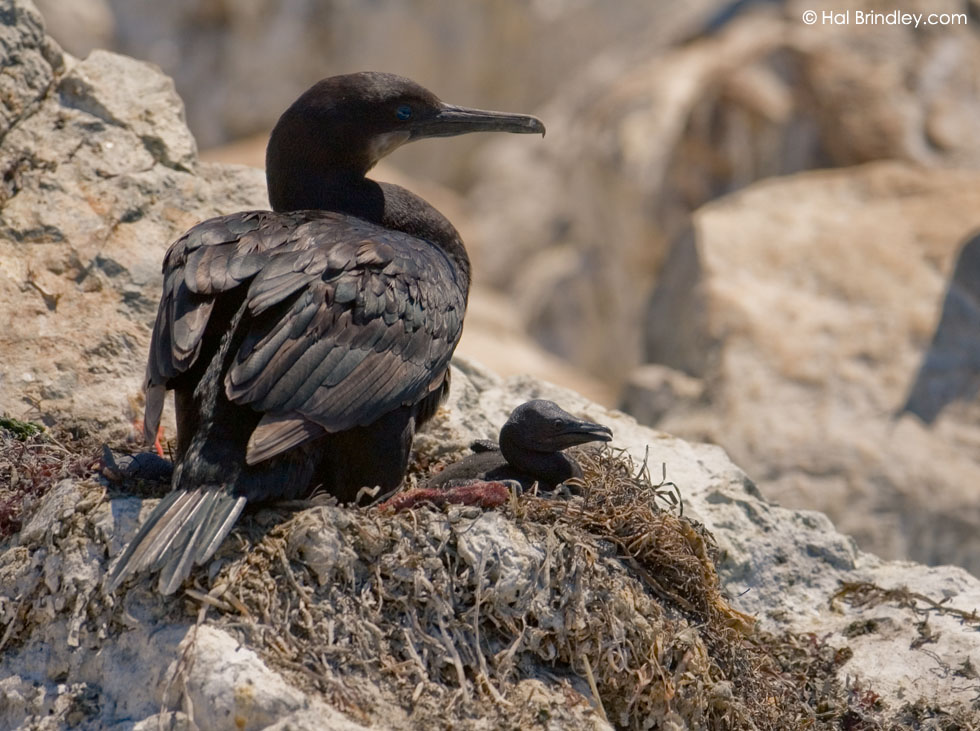
Although sea lions are carnivores, they have no interest in eating these birds. Their preferred diet is fish, squid, abalone and other underwater creatures.
However, a bird may, on certain occasions, eat a sea lion. (huh?) …

I found this dead sea lion washed up on the beach in Montaña de Oro State Park. Two different bird species were dining on it, a Turkey Vulture and this Western Gull. I know this might seem in bad taste, but I assure you it tastes pretty darn good to a gull. Mmmmmm, seal butt. OK, that was in bad taste.
Another interesting California Sea Lion fact: they are the fastest of the pinnipeds and are able to swim at speeds of up to 25 miles per hour! Oh yeah, speaking of biting off more than you can chew…
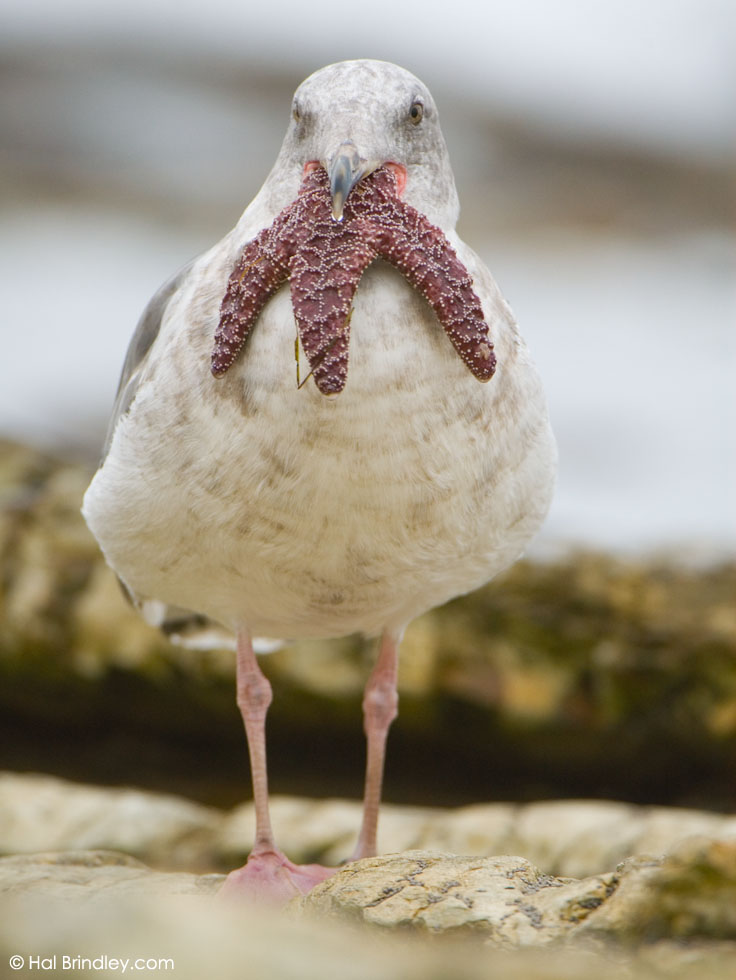
I saw this juvenile Western Gull trying to swallow a whole starfish in one bite. For nearly half an hour it tried and tried but to no avail.
Eventually I got bored of waiting and moved on to watch some otters. Ten minutes later I glanced over and the starfish was finally on its way down. After swallowing it, the gull’s neck bulged comically like a cartoon character who has just swallowed an anvil sideways. You go, gull. Keep reachin’ for the stars.
But back to the subject at hand.
Marine Mammal 4: The Steller Sea Lion.

I actually photographed this steller feller off the coast of Washington State, a week after visiting California, but we’ll get to that tale in a minute.
The Steller Sea Lion is quite similar to the California Sea Lion only it’s huge (twice as big as the California) weighing up to 2,000 pounds! That makes it the largest of the eared seals. They are a somewhat rare sight in Washington, so I was very pleased to catch a glimpse of one.
Now it’s time to get to the biggest pinniped of all, the deepest diver, and the one with the most hilarious nose …
Marine Mammal 5: The Elephant Seal.
Wow. These guys are amazing and fascinating in so many ways, but to me their funniest feature is the big nose.
Much like Pinocchio, the male’s nose will continue to grow throughout his lifetime. Hence, the biggest and oldest males are the ones with the biggest, most killer schnozz. Apparently, female elephant seals find this supremely attractive. Can you blame them? Don’t the ladies generally go for the biggest, fattest guy on the beach with a nose that hangs down to his chin and scars all around his neck? (That’s another sign of a big, bad bull elephant seal, lots of battle scars.) The nose is also used to amplify their great bellowing roars during mating season.
What else is so amazing about elephant seals you say? Don’t get me started …
Amazing fact #1. They are huge. I mean HUGE.
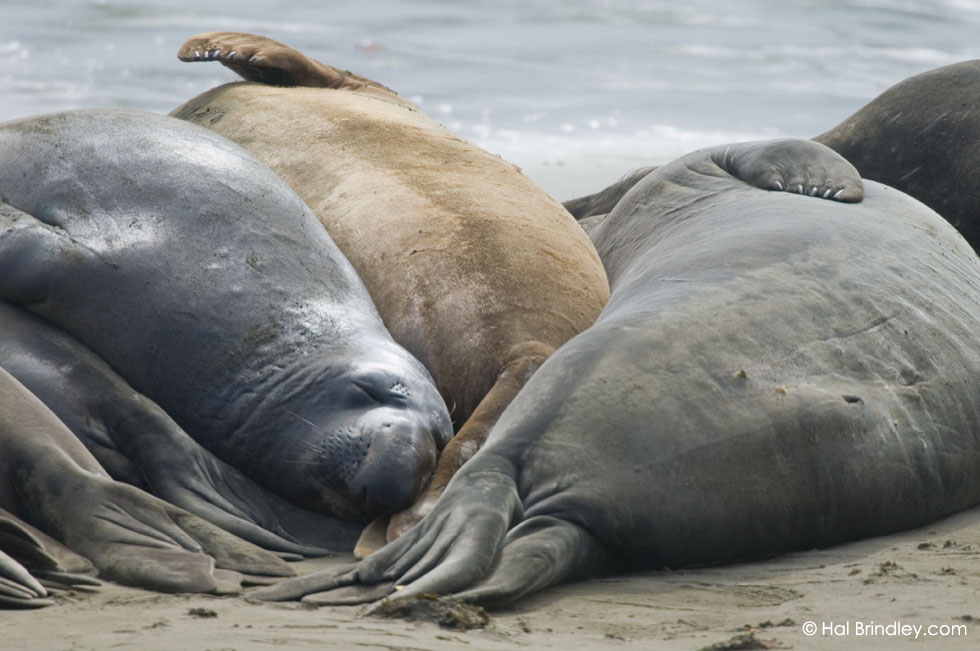
There are two species of elephant seal, the Southern and Northern. The ones I photographed here at the Piedras Blancas rookery are Northern Elephant Seals. They can weigh up to 3 tons. That’s 6,000 pounds folks. It’s tough to get a real sense of how heavy 6,000 pounds is, but consider this: my car, a Toyota Rav4, weighs approximately 3,000 pounds. A Northern Elephant Seal can weigh twice as much as my car and grow up to 18 feet long. That’s a big seal.
But get this. These are the little guys. The Southern Elephant Seal can grow to 8,000 pounds and be up to 21 feet long. Holy moly…
Massive size is generally considered an adaptation for efficient heat retention among deep diving marine mammals. But it also creates a paradoxical problem at the breeding colony.
Amazing Fact #2. The number one cause of death among young elephant seal pups is getting squished.
Imagine a 3 to 4 ton male barreling across the beach to mate with a receptive female and you are a tiny pup in its path. You would probably have this look on your face and be thinking something along the lines of “oh crud.”
Amazing Fact #3. Elephant seal milk has the richest fat content of any mammal, about 54%! (Compare that to cow’s milk which has about 5% fat.)
Amazing Fact #4. Thanks to its fat-packed diet, a baby Northern Elephant Seal will more than triple its weight in its first month of life. (93 lbs. to 280 lbs. on average.)
Amazing Fact #5. Elephant Seals exhibit the most extreme sexual dimorphism of any mammal (physical difference between males and females of the same species). The males are WAY bigger than the females.
A male Southern Elephant Seal can weigh more than seven times as much as the female it is mating with. That would be like the world’s heaviest man Jon Minnoch (who according to the Guinness Book was approximately 800 lbs at the time of his death) hooking up with 105 pound Kate Moss. Eek. The young males in this photo are not battling for mates, merely practicing their intimidation skills. In fact, I wasn’t there during the mating season at all. What I witnessed was the molt …
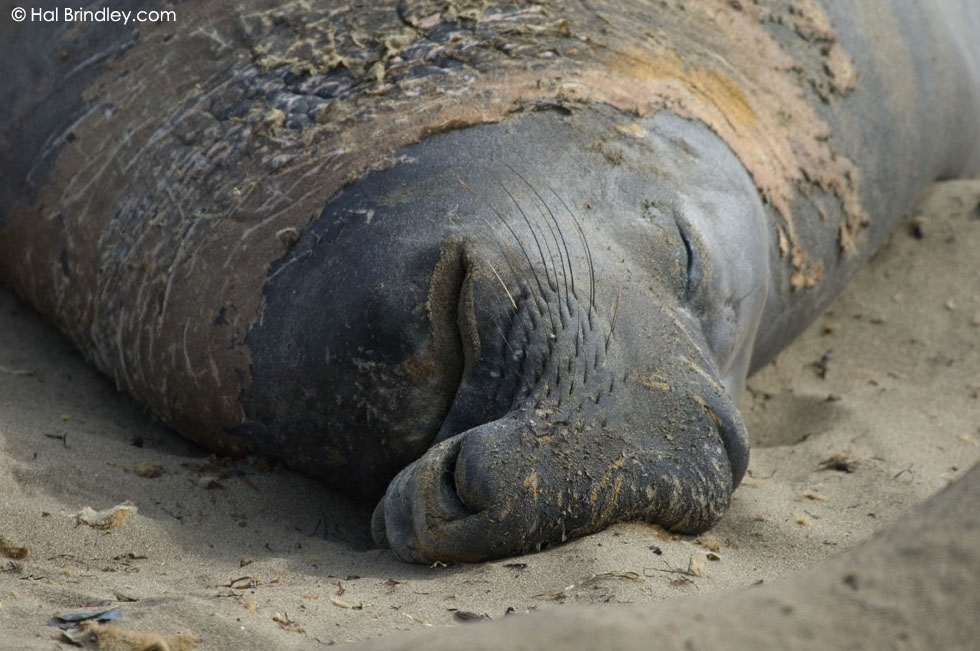
Every year elephant seals undergo what is known as a “catastrophic molt” where they shed their outer layer of skin and hair. It falls off in huge patches revealing a fine, dark layer of new hair and skin, as shown here. They molt on the same beach where they bred several months earlier.

Amazing Fact #6. The elephant seal is the only mammal to complete a DOUBLE long distance migration. Each year they molt on these beaches in California and Baja, then swim all the way up to the coast of Alaska to feed, then back down again to the exact same beaches to give birth and mate, then all the way back up again to feed. That can be as much as a 13,000 mile round trip for each migration, grand total: up to 26,000 miles of migration each year. This makes them the world record holder for mammal migration. How far is 26,000 miles? The circumference of the earth is just under 25,000 miles. Imagine trying to swim a lap all the way around the world. Now imagine doing it every year of your life. They may be fat but they ain’t lazy.
And now, the grand finale, Amazing Fact #7. They are the world record holders for deepest and longest dives of any air breathing animal on our planet. Based on recorded data they can dive deeper and stay under longer than even the deepest diving whales. They are the grand champions of adaptive evolution. It just boggles my mind. A creature that started out as a land based carnivore in the distant past, like a bear or a wolf or a weasel, ‘figured out’ how to return to the water and exploit a food source at the bottom of the deepest blue sea. Their genes found a way to overcome the need to breathe.
The winner for longest recorded time underwater on a single breath goes to a Southern Elephant Seal. 120 minutes. Two freakin’ hours.
The distinction of deepest depth recorded belongs to a Sorthern Elephant Seal. 7,000 feet. Well over a mile down.
Please give a moment of appreciation to the Elephant Seal. This is truly, truly amazing.
OK, now you may continue. . .
The final fact about the Northern Elephant Seal is, to me, the most amazing of all. We nearly hunted this incredible creature to extinction.
The whaling industry slaughtered them for their blubber, to light our lamps. By 1890 they were actually considered extinct. Gone forever.
Then, miraculously, a colony of less than 20 individuals was found on Guadalupe Island off Baja California in 1892. I suppose we could have lit a few more lamps with them but some kind individual decided to protect them instead.
A hundred years later their population was estimated to be a mere 125,000. Their numbers continue to grow but they are still vulnerable. Let’s keep them around shall we?
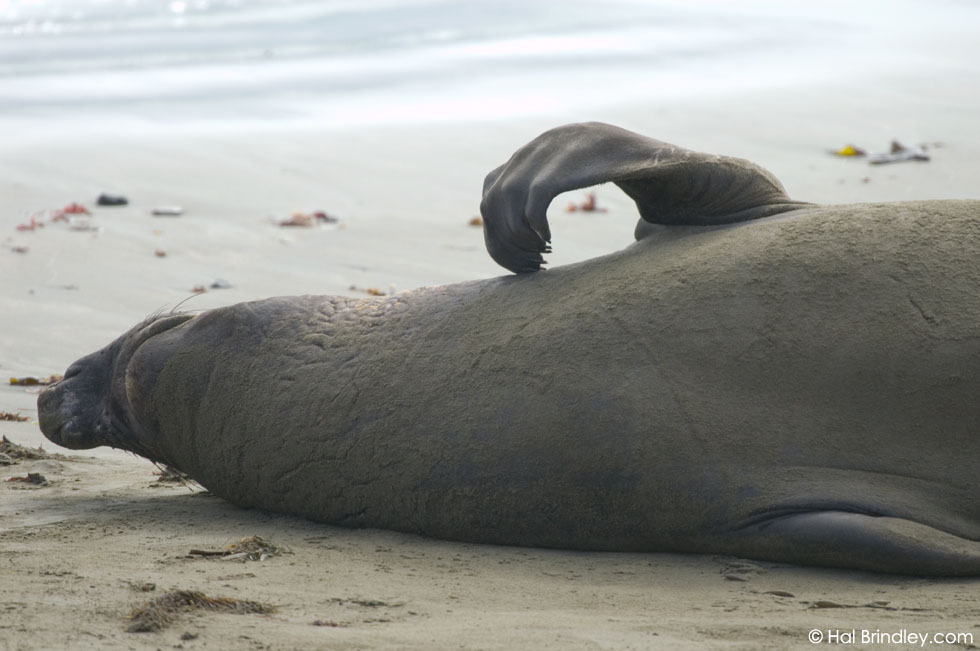
And now, on to marine mammal number six …
Oh, by the way, if you visit the Piedras Blancas elephant seal rookery you will see some very tame California Ground Squirrels in the parking lot begging for food.

It is pretty much always a bad idea to feed wild animals, for all sorts of reasons, but good-golly, people can’t seem to resist. Doritos are not a good diet for any living creature, trust me.
As a card carrying member of NANPA I am sworn to uphold ethical behavior when photographing wildlife, so I didn’t feed this little guy. But I did take advantage of his tameness to get this shot. Ooh, so tough to resist. Where was I…
Oh yes,
Marine Mammal 6: The Gray Whale.
Unlike Pinnipeds, whales and dolphins (known as Cetaceans) are marine mammals that have completely severed their ties to the land. Yes they still breath air but they live, eat, sleep, mate and give birth at sea. There are 85 species worldwide that are divided into two categories: toothed whales (including all dolphins and porpoises, sperm whales, beaked whales, belugas and narwhals) and baleen whales (13 species of ‘filter-feeding’ whales). The Gray Whale is a baleen whale meaning it has long baleen plates in its mouth for filtering tiny food items from the water. The unique thing about the gray whale is that it does not filter through open water like all other baleen whales. It scoops up a mouthful of mud off the bottom and filters its dinner out of the sludge. Yummy! We spotted this Gray Whale feeding off the coast of Washington State in the San Juan Islands.

Incidentally that island in the back belongs to Paul Allen, co-founder of Microsoft. If you were one of the richest men in the world you could whale-watch from your newly-built conference center too. How did we end up in Washington all of a sudden?. . .
I came here for the specific reason of locating marine mammal #7. (Also to locate a certain mammal that I met at the wedding one week earlier in California, but that’s a different story).
Have you figured out what it is?
No, they’re not sharks. (Sharks are fish, not mammals, silly.)
But they are one of the earth’s most amazing predators ever …
Marine Mammal 7: The Orca (A.K.A the Killer Whale)
It has been a dream of mine for many years to see orcas in the wild.
My dream finally came true. Seeing a pod of these sleek predators hunting together like a pack of wolves was absolutely thrilling.
A pod is a group of whales that travel together. In orca society the pods are matriarchal, formed around older females and their offspring. There are 90 members of the “Southern Resident” population near the San Juan Islands, consisting of three pods named J, K and L. (Not very creative I know but scientific research isn’t known for being colorful.)
Here’s a quiz for you. Killer Whales possess the biggest (blank) of any whale on the planet? Hint: males have one that can be over six feet long …
No it’s not his free willie. Nice try ladies.
I’m afraid the answer is “dorsal fin.”
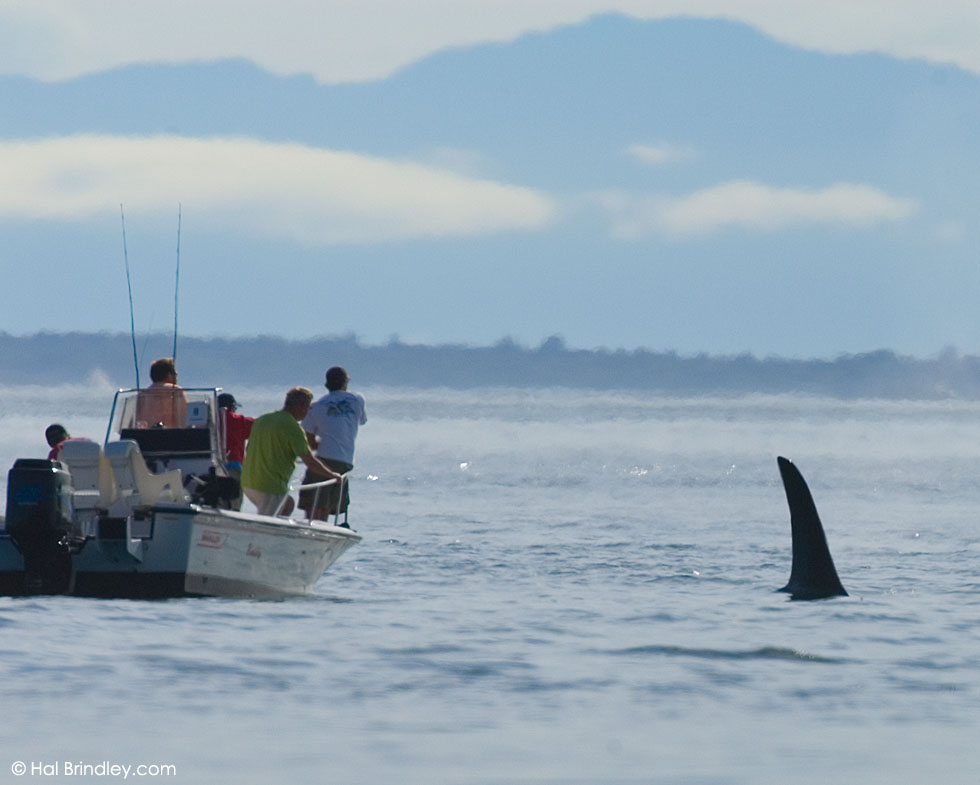
That’s right. A male orca can have a dorsal fin that is over 6 feet tall, the tallest of any whale or dolphin in the world. A female’s dorsal fin is typically only about 2 feet tall. So you can tell a big male like this one at a glance. How big is a big male? They can grow up to 29 feet long. Zowie. Seeing those huge dorsal fins cruising along was a truly awesome sight.
Here’s the cool thing about San Juan Island; you can watch killer whales from the shore. These last three photos were all shot from Lime Kiln State Park on San Juan Island.
One minute you’re sitting there having a nice picnic, the next minute all three pods of killer whales appear out of nowhere, frolicking together in Haro Strait. At least that’s what happened to us. It’s the coolest I tell ya.
You don’t have to be on a whale watching boat to find them. Of the three whale-watch cruises I did take, only once did we find the orcas. But hoo lordy was it worth it when we finally did. They were feeding far out from shore in the rough waters of the Strait of Juan de Fuca near Vancouver Island in Canada.
There I witnessed something I never dreamed I would see in my whole life…
Orcas breaching. I’m talkin’ full breach, clear out of the water. It was insane. They were just going nuts out there, tail slapping, fin slapping, spy hopping, the whole nine yards. The seas were so rough it seemed I had no hope of actually photographing them. I could barely stand up on our little boat, let alone devote both hands to holding up a 400mm lens and swinging it around in time to aim and focus on a breaching orca. I nearly threw my gear and myself overboard on several occasions. I credit 15 years of skateboarding and bmx freestyle riding for giving me the balance it took to stay on board.
Miraculously, I did get lucky on this one shot, my favorite shot of the trip.

With this glorious moment I shall end our tour of the marine mammals of the Pacific Coast. Whew. Good times. I hope you enjoyed it as much as I did and I hope you’ll remember to appreciate and protect our incredible mammalian cousins in the sea

